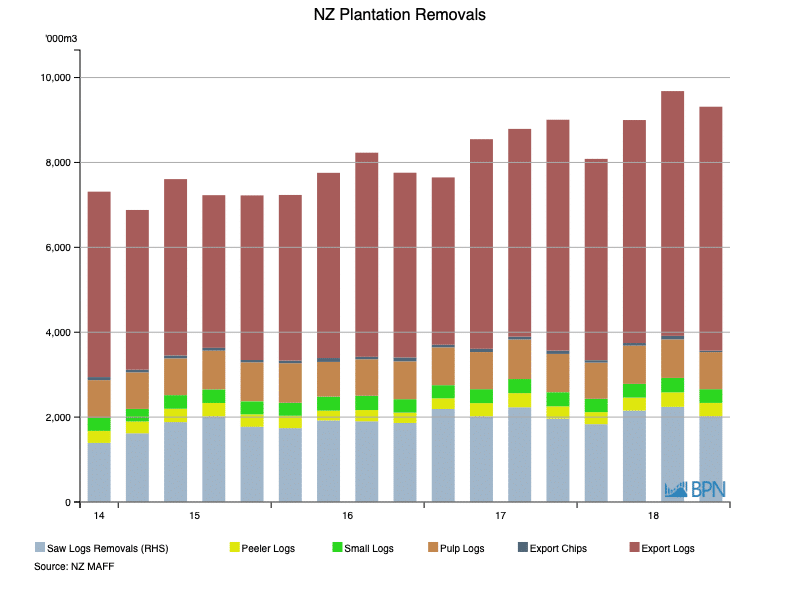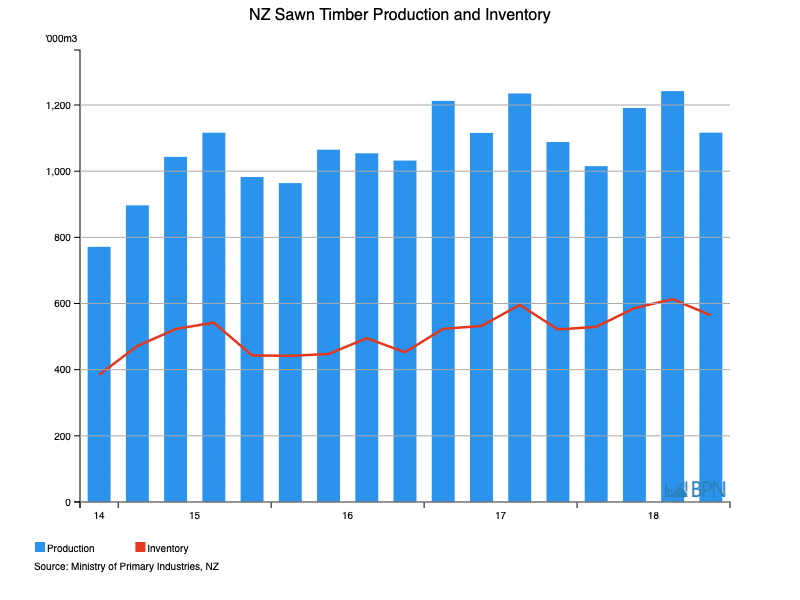Latest data shows that New Zealand’s total harvest remains at near record levels, while somewhat counter-intuitively, Sawnwood production has slumped. In 2018, the reported total harvest was up 6.1% on 2017, reaching 36.077 million m3, supported primarily by export log growth of 12.0%. Unsurprisingly, given softer sawnwood production, sawlog extractions were 1.8% lower over the year.
As the chart shows, the December quarter of 2018 saw New Zealand’s harvest at its second highest ever level, bested only by the prior quarter. At 5.747 million m3, DQ’18’s extractions were just 20,000 m3 (0.3%) lower than in SQ’18.

To go straight to the dashboard and take a closer look at the data, click here.
The table below shows the annualized data for 2017 and 2018 and provides comparisons between them. For our part, the major interest is in the decline in Saw Log removals and the rise in Export Log removals, because it demonstrates a changing pattern in the major use of New Zealand’s logs.
It is important to note that these are not symmetrical. That is to say, the rise in extraction of Export Logs of 12.0% in 2018 amounted to 2.296 million m3 more, while the decline in Saw Log extraction was just 0.155 million m3. Except possibly at the margin, they are not connected.
| 2017 | 2018 | % Change | |
| Saw Logs | 8,402 | 8,248 | -1.8% |
| Peeler Logs | 1,190 | 1,249 | 4.9% |
| Small Logs | 1,298 | 1,300 | 0.1% |
| Pulp Logs | 3,603 | 3,534 | -1.9% |
| Export Chips | 281 | 234 | -16.8% |
| Export Logs | 19,216 | 21,512 | 12.0% |
| Total | 33,991 | 36,077 | 6.1% |
Plenty of circumstances can account for changing harvest patterns. Different plantation areas, asymmetric plantation estates, and of course, varying patterns of demand, can all have an effect.
In that context, we examined New Zealand’s sawnwood production data. Unsurprisingly given the log extraction data, New Zealand’s sawnwood production fell 1.9% in 2018 (compared with 1.8% decline in sawlog extractions). Sawn wood production totalled 4.565 million m3 over the year. The chart below shows the details on a quarterly basis, which include quarterly inventory levels.

To go straight to the dashboard and take a closer look at the data, click here.
Sawnwood inventories are notable for a variety of reasons, but especially here because they appear to have grown more or less consistently with the growth in production.
As an example, New Zealand’s sawn wood production declined 10.1% to 1.116 million m3 in the December quarter compared with the September Quarter, while inventories were 8.0% softer. Importantly, despite its modest softening, DQ’18s sawnwood production in New Zealand was 2.7% higher than in DQ’17.
On this headline data, despite some variances, the New Zealand industry continues to be producing at near record levels.



